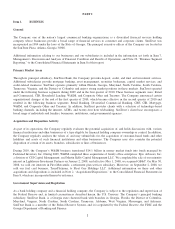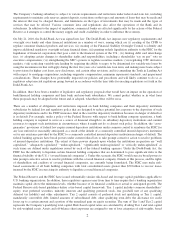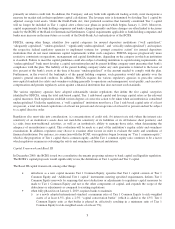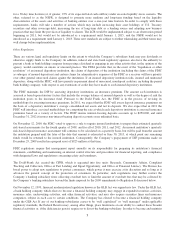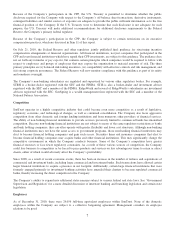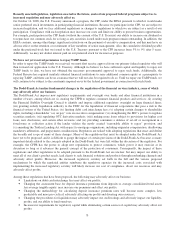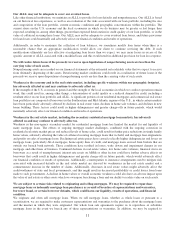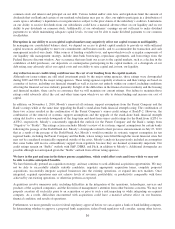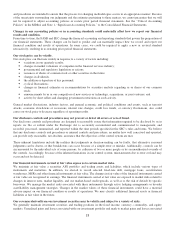SunTrust 2010 Annual Report Download - page 25
Download and view the complete annual report
Please find page 25 of the 2010 SunTrust annual report below. You can navigate through the pages in the report by either clicking on the pages listed below, or by using the keyword search tool below to find specific information within the annual report.Recently enacted legislation, legislation enacted in the future, and certain proposed federal programs subject us to
increased regulation and may adversely affect us.
On October 14, 2008, the U.S. Treasury announced a program, the CPP, under the EESA pursuant to which it would make
senior preferred stock investments in participating financial institutions. Because we participate in the CPP, we are subject to
increased regulation, and we face additional regulations or changes to regulations to which we are subject as a result of our
participation. Compliance with such regulation may increase our costs and limit our ability to pursue business opportunities.
For example, participation in the CPP limits (without the consent of the U.S. Treasury) our ability to increase our dividend or
to repurchase our common stock for so long as any securities issued under such program remain outstanding. In addition, the
EESA contains, among other things, significant restrictions on the payment of executive compensation, and this may have an
adverse effect on the retention or recruitment of key members of senior management. Also, the cumulative dividend payable
under the preferred stock that we issued to the U.S. Treasury pursuant to the CPP increases from 5% to 9% after 5 years.
Additionally, we may not deduct interest paid on our preferred stock for income tax purposes.
We have not yet received permission to repay TARP funds.
In order to repay the TARP funds we received, we must first receive approval from our primary federal regulator who will
then forward our application to the U.S. Treasury. Although we believe we have sufficient capital and liquidity to repay our
TARP funds, to date, we have not obtained the necessary governmental approval to repay such funds. Additionally, the
Federal Reserve has required similarly-situated financial institutions to raise additional common equity as a prerequisite to
repaying TARP, and there can be no assurance that we will not also be required to do so. Until we repay our TARP funds, we
will continue to be subject to the constraints imposed on us by the federal government in connection with such funds.
The Dodd-Frank Act makes fundamental changes in the regulation of the financial services industry, some of which
may adversely affect our business.
The Dodd-Frank Act imposes new regulatory requirements and oversight over banks and other financial institutions in a
number of ways, among which are (i) creating the CFPB to regulate consumer financial products and services; (ii) creating
the Financial Stability Oversight Council to identify and impose additional regulatory oversight on large financial firms;
(iii) granting orderly liquidation authority to the FDIC for the liquidation of financial corporations that pose a risk to the
financial system of the United States; (iv) limiting debit card interchange fees; (v) adopting certain changes to shareholder
rights, including a shareholder “say on pay” vote on executive compensation; (vi) strengthening the SEC’s powers to regulate
securities markets; (vii) regulating OTC derivative markets; (viii) making more loans subject to provisions for higher cost
loans, new disclosures, and certain other revisions; and (ix) providing consumers a defense of set-off or recoupment in a
foreclosure or collection action if the lender violates the newly created “reasonable ability to repay” provision; and
(x) amending the Truth in Lending Act with respect to mortgage originations, including originator compensation, disallowing
mandatory arbitration, and prepayment considerations. Regulators are tasked with adopting regulations that enact and define
the breadth and scope of many of these changes. Many of the regulations that must be adopted under the Dodd-Frank Act
have yet to be proposed, and it is difficult to gauge the impact of certain provisions of the Dodd-Frank Act because so many
important details related to the concepts adopted in the Dodd-Frank Act were left within the discretion of the regulators. For
example, the CFPB has the power to adopt new regulations to protect consumers, which power it may exercise at its
discretion so long as it advances the general concept of the protection of consumers. Consequently, the impact of these
regulations and other regulations to be adopted pursuant to the Dodd-Frank Act are unclear, but may impact our ability to
meet all of our client’s product needs, lead clients to seek financial solutions and products through nonbanking channels and
adversely affect profits. Moreover, the increased regulatory scrutiny set forth in the bill and the various proposed
mechanisms by which the regulated entities reimburse the regulatory agencies for the increased costs associated with
implementing the increased regulatory scrutiny will likely increase our cost of compliance, divert our resources and may
adversely affect profits.
Among those regulations that have been proposed, the following may adversely affect our business:
•Limitations on debit card interchange fees may affect our profits;
•Changing the assessment base for deposit insurance premiums from deposits to average consolidated total assets
less average tangible equity, may increase our premiums and affect our profits;
•Changing the methodology for calculating deposit insurance premium rates will become more complex, less
predictable and more pro-cyclical, adversely affecting our profits and diverting our resources;
•Changing the procedures for liquidation may adversely impact our credit ratings and adversely impact our liquidity,
profits, and our ability to fund ourselves;
•Increases in requirements for regulatory capital while eliminating certain sources of capital may adversely affect our
profits;
9




